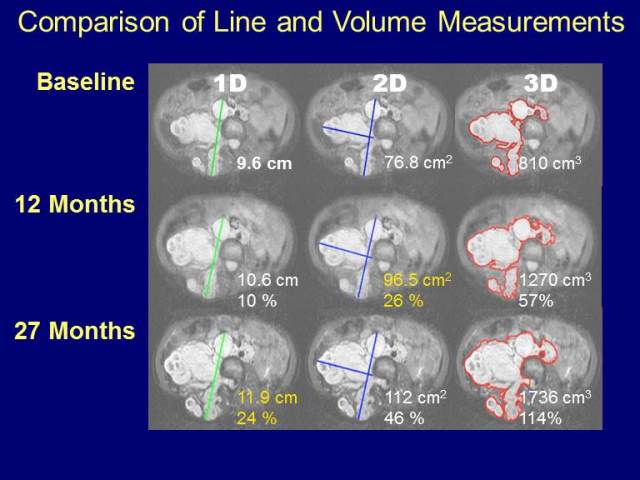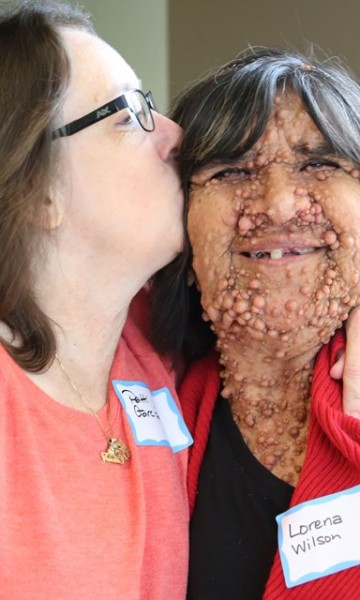Volumetric Measurement of Tumors in Neurofibromatosis
At NF Midwest’s annual symposium in October 2014 we invited Eva Dombi, MD, from the National Cancer Institute to present information about how a newer technology called volumetric measurement is used to measure tumors in neurofibromatosis. The transcript from her presentation is now available online on our website.
What is Volumetric Measurement and How is it Used
 Internal plexiform tumors in neurofibromatosis type 1 can be very difficult to measure using traditional methods. This is because they often have varying, undefined edges. They are usually composed of segments or lobes and may have trunks that branch out in different directions. Small tumors in critical spaces, where the smallest changes are relevant, such as those found in NF type 2, can also be difficult to measure.
Internal plexiform tumors in neurofibromatosis type 1 can be very difficult to measure using traditional methods. This is because they often have varying, undefined edges. They are usually composed of segments or lobes and may have trunks that branch out in different directions. Small tumors in critical spaces, where the smallest changes are relevant, such as those found in NF type 2, can also be difficult to measure.
Because they are hard to measure, researchers and clinicians have found it difficult to accurately tell how much these tumors shrunk or grew when conducting clinical trials. This makes it difficult to assess the true effect of a new drug.
To solve this problem a new measurement method was developed called volumetric MRI analysis. This is NOT a type of MRI, but rather a trained specialist with a special computer system that is able to analyze the images of the tumor provided by MRI scans to come up with a volume to the tumor.
As a very basic description of how the volumetric measuring works… A computer program helps to identify the contour of the tumor on every MR-image that shows tumor. The outline of the tumor is verified and the volume within that contour is calculated by the program.
The National Cancer Institute (NCI, part of the National Institutes of Health – NIH) and Massachusetts General Hospital (MGH) are currently the only institutions that have the skills and technology to take MRI scans and measure the volume of an NF tumor in this way.
In order to perform volumetric analysis, the MRI may be done almost anywhere but the images have to be done a certain way. The MRI scans need to be of high quality and must be done using a technique called a STIR sequence. The images also must include the entire tumor and all parts of the tumor must be imaged with the same image parameters…for instance, at the same angle and image resolution. Small NF2 related tumors are best imaged with high resolution T1 post contrast sequence. If the MRI is done in this way, they may be sent at any time to the NCI or MGH for analysis.
The important thing to understand is that an MRI can be done at another institution as long as it uses the correct parameters. It is the scans that are measured and analyzed. Also, it takes two MRIs, with a period of possible growth or shrinkage between them to establish any useful information. In other words, two MRIs need to be compared to each other.
Volumetric analysis is currently mainly done on tumors from patients who are in a clinical trial or have the potential to be in a clinical trial.
For more information about volumetric measurement and when needed, please talk to your NF specialist.
Here are some slides that might help you to understand volumetric measurement a little more.







.png)





